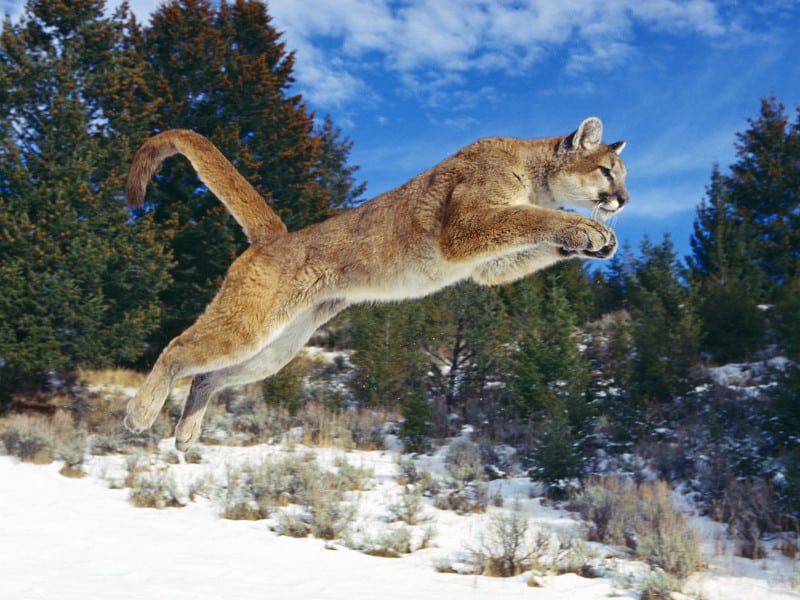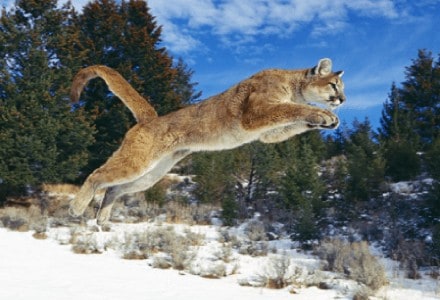
Cougar Facts
- The short term of Cougar serves as but one of the common names assigned to this magnificent wild feline. It other common names include the mountain lion, puma, painter, panther, and catamount. The variety of names occur due to its wide range.
- Scientists, meanwhile, know the stunning feline by the term Puma concolor. Regardless of the name one uses for it, the animal remains one of the most recognizable of the smaller wild felines. It’s also the most widespread of any in its Hemisphere.
- The renowned Swedish zoologist, Carl Linnaeus, holds the credit for the first acknowledged scientific recognition and naming of the species. This achievement he accomplished in 1771. The name he chose, however, later changed several times.
- This breathtaking feline obviously evolved as a slender and agile member of the cat family. It also holds a unique distinction. That’s because, though not technically one of the so-called big cats, it’s the fourth largest of all known wild felines.
- Even though its population doesn’t compare to past numbers, this appears stable throughout its range. The IUCN, therefore, currently lists it as Least Concern. It does face several threats, including the ever-increasing danger posed by climate change.
Related Articles
Iberian Lynx Snow Leopard Cheetah
Cougar Physical Description
Unlike some species, the breathtaking Cougar actually impresses us with its size, in addition to other factors. The animal also, however, displays the physiological characteristic of sexual dimorphism. In this, in fact, it mirrors virtually all know types of feline, wild and domestic.
In its specific case, though, this trait manifests in terms of size, with males of the species attaining slightly greater lengths and weights. Mature adults of both genders, however, vary greatly in height, averaging between 24 -35 in (60 – 90 cm) tall at the shoulders.
In terms of length, meanwhile, is where the size differences appear the most obvious. The males of this feline attain an average nose-to-tail length equaling roughly 7.9 ft (2.4 m). Females, however, generally reach an overall length of about 6.7 ft (2.05 m).
It bears pointing out, though, that of this total measurement, the tail itself comprises 25 – 37 in (63 – 95 cm) of this. The males, meanwhile, typically reach a weight of between 115 – 220 lb (53 – 100 kg). Females, on the other hand, average 64 – 141 lb (29 – 64 kg).
The Cougar also boasts other impressive statistics. Its rounded head displays erect ears. The feline has a jaw and forequarters powerful enough to grasp large prey. It also has five retractable claws on the forepaws, and proportionately the largest hindlegs in the cat family.
- Kingdom: Animalia
- Phylum: Chordata
- Class: Mammalia
- Order: Carnivora
- Family: Felidae
- Genus: Puma
- Species: P. concolor
Cougar Distribution, Habitat, and Ecology
Pleasantly surprisingly, the gorgeous Cougar inhabits a comparatively large section of the globe. More precisely, it appears in a range that extends from parts of Canada to the Andes in South America. Its greatest concentration, however, is concentrated in North America.
Aiding in its continued existence as a species is the fact that it evolved as a highly adaptable creature. This flexibility allows it to inhabit a wide variety of habitat types within its native range. Most notably, though, these include forests, lowlands, mountains, and arid climates.
Its incredible physique allows the impressive feline some of the greatest leaping and short-sprint ability of any animal. Individuals have the ability to jump as high as 18 ft (5.5 m) in one bound. These also evolved the capacity to leap as far as 40-45 ft (12-14 m) horizontally.
But Nature did not stop there. This animal also boasts some extremely impressive speeds. The top running velocity of the animal also ranges between 40-50 mph (64-80 kph). They remain, however, best capable of short, powerful sprints as opposed to long chases.
The remarkable Cougar also feeds entirely as a carnivore. As a supremely successful generalist predator, the mammal further feeds opportunistically. Specimens therefore eat any animal they can catch, from insects to large ungulates in excess of 1,100 lbs (500 kg).
Investigations in Yellowstone National Park showed that elk, followed by mule deer, were the animal’s primary targets. The mammal further evolved as adept at climbing, allowing it to evade canine competitors. Although not strongly associated with water, it does swim.
Species Sharing Its Range
Mara Eastern Diamondback Rattlesnake Viscacha
Check out our other articles on Amur Leopard, Marbled Cat, Asian Golden Cat, Lynx, Golden Tabby Tiger, Grizzly Bear, 5 Spectacular North Carolina Spiders, Cypripedium calceolus

